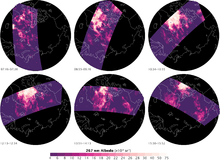Polar mesospheric clouds
| Polar Mesospheric Clouds | |
|---|---|
|
Polar mesospheric clouds over the north pole | |
| Altitude |
75,000 to 85,000 m (250,000 to 280,000 ft) |

Polar mesospheric clouds (PMCs) are a diffuse scattering layer of water ice crystals near the summer polar mesopause.
Description
Observed from the ground, this phenomenon is known as noctilucent clouds. From satellites, PMCs are most frequently observed above 70°-75° in latitude and have a season of 60 to 80 days duration centered about a peak which occurs about 20 days after the summer solstice. This holds true for both hemispheres. Great variability in scattering is observed from day-to-day and year-to- year, but averaging over large time and space scales reveals a basic underlying symmetry and pattern. The long- term behaviour of polar mesospheric cloud frequency has been found to vary inversely with solar activity.
When mesospheric clouds are viewed above the atmosphere, the geometrical limitations of observing from the ground are significantly reduced. They may be observed ‘edge-on’ against the comparatively dark sky background, even in full daylight. The photometer field of view must be well baffled to avoid interference from the very bright Earth about a degree beneath the cloud layer. It is a much more difficult task to observe the clouds against the bright background of the illuminated Earth, although this has been achieved in the ultraviolet in the 200 to 300 nm spectral region, because of the very small albedo of the earth in this part of spectrum.
American and Soviet astronauts observed the phenomenon from space as early as 1970. Most observations are reported from the night side of the orbit and the observer is looking towards the twilight sector. At this time the observer's eye is dark-adapted and polar mesospheric clouds would appear with maximum contrast against a comparatively dark background. Soviet astronauts have reported sightings of mesospheric clouds even when the Sun is above the horizon.
Satellite observations allow the very coldest parts of the polar mesosphere to be observed, all the way to the geographic pole. In the early 1970s, visible airglow photometers first scanned the atmospheric horizon throughout the summer polar mesospause region (Donahue et al., 1972). This experiment, which flew on the OGO-6 satellite, was the first to trace noctilucent-like cloud layers across the polar cap. The very bright scattering layer was seen in full daylight conditions, and was identified as the poleward extension of noctilucent clouds. In the early 1980s, the layer was observed again from a satellite, the Solar Mesospheric Explorer (SME) . On board this satellite was an ultraviolet spectrometer, which mapped the distributions of clouds over the time period 1981 to 1986. The experiment measured the altitude profile of scattering from clouds at two spectral channels (primarily) 265 nm and 296 nm (Thomas and MacKay, 1985). This phenomenon is now known as Polar Mesospheric Clouds.
The general seasonal characteristics of polar mesospheric clouds are well established from the five years of continuous SME data. Over that period, data for four cloud ‘seasons’ in the north, and five ‘seasons’ in the south were recorded. In both hemispheres, the season begins about one month before summer solstice and ends about two months afterwards. Since there are no biases due to such factors as changing number of hours of visibility, weather conditions, etc. this is a ‘true’ behaviour. It is believed to be a result of the fact that summertime mesopause region becomes coldest during this period causing water-ice to form, in contrast to most other regions of the atmosphere which are warmest in summer. Temperatures at latitudes equatorward of the boundary of detection never get low enough for water-ice to form.
Polar mesospheric clouds generally increase in brightness and occurrence frequency with increasing latitude, from about 60 degrees to the highest latitudes observed (85 degrees). So far, no apparent dependence on longitude has been found, nor is there any evidence of a dependence on auroral activity (Thomas and Olivero, 1989). This indicates that control of polar mesospheric clouds is determined by geographical rather than geomagnetic factors. The brightness of polar mesospheric clouds and noctilucent clouds appears to be consistent at the latitudes where both are observed, but polar mesospheric clouds near the pole are much brighter than noctilucent clouds, even taking into account the lower sky background seen from space. Polar mesospheric cloud observations have revealed that the well-known phenomenon of the northward shifting with latitude of date of peak noctilucent cloud occurrence is partly due to the increased number of hours of noctilucent cloud visibility with latitude and partly due to an actual northward retreat of the boundary towards the end of the season.
See also
| Wikimedia Commons has media related to Noctilucent clouds. |
- Iridescent Cloud
- Noctilucent clouds
- Polar stratospheric clouds
- Aeronomy
- Aeronomy of Ice in the Mesosphere
